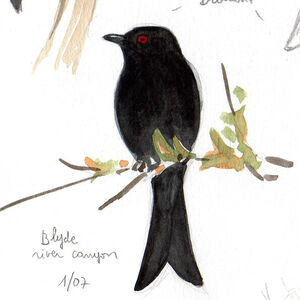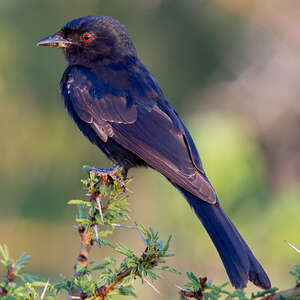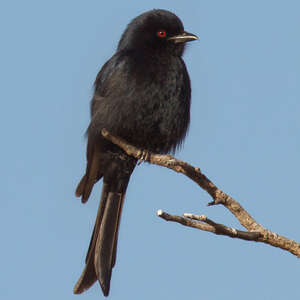Fork-tailed Drongo
Dicrurus adsimilis - Drongo brillant
Identification
The Fork-tailed Drongo is a quite large bird (25 cm) with half of its length composed of its forked tail. From afar, the adult appears entirely black, but up close in good light, its feathers show a glossy metallic sheen of blue or blue-green that shines in the sun. The wings are the only part of its body that doesn't have this iridescent sheen, the remiges often looking more brown than the rest. When the bird is in flight, the undersides of the wings appear much paler than the rest of its body. The rectrices are especially long (115 to 126 mm) with a difference of more than 2 cm between the middle and the external feathers, giving the tail its characteristic forked look. Its iris has an intense red color. The strong beak, slightly curved at the tip, and the surrounding vibrissae are characteristic of drongos. Its legs are black and short.
The juvenile has a dark brown color mottled with small reddish spots at the tips of the feathers. Its tail is much less forked than that of the adult. Its iris is brown. The immature looks like the adult but with fewer shiny reflections and its undersides are paler.
Formerly, the Fork-tailed Drongo comprised numerous subspecies. Currently, only four are recognized. They differ slightly in overall size, shape, and length of the tail, and in their minor color differences.
D. a. adsimilis is the type subspecies described above.
D. a. divaricatus is smaller with a tail notch lower than 2 cm.
D. a. fugax is small with a deeply forked tail (23 to 27 mm).
D. a. apivorus is large with pale grey undersides of the wings.
Subspecific information 6 subspecies
- Dicrurus adsimilis adsimilis (w Swaziland and e and s South Africa)
- Dicrurus adsimilis apivorus (se Gabon and Congo to n South Africa)
- Dicrurus adsimilis jubaensis ()
- Dicrurus adsimilis fugax (Uganda and Kenya s to ne South Africa and Swaziland)
- Dicrurus adsimilis divaricatus ()
- Dicrurus adsimilis lugubris ()
Foreign names
- Drongo brillant,
- Drongo ahorquillado,
- drongo-de-cauda-forcada,
- Trauerdrongo,
- szuaheli drongó,
- Treurdrongo,
- Drongo codaforcuta,
- klykstjärtad drongo,
- Savannedrongo,
- drongo vidlochvostý,
- drongo africký,
- Gaffelhalet Drongo,
- sieppodrongo,
- Mikstertbyvanger,
- drongo cuaforcat,
- dziwogon żałobny,
- Траурный дронго,
- クロオウチュウ,
- 叉尾卷尾,
- klykstjärtad drongo,
- 叉尾卷尾,
Voice song and call
The Fork-tailed Drongo is very vocal. It is often the first bird to sing in the morning and the last one in the evening. Its repertoire is very varied and difficult to transcribe. It includes short metallic and liquid whistles, grating notes, and discordant sounds, in a varied babble that can be emitted continuously or at quite long intervals. The long monologues are often very expressive in this bird, for example: Drit-drit, woyglo-jit, drit-o, jewp-jewp, clic-clic, gliglaagligloo, jick-glo-jeea. The Fork-tailed Drongo is a talented mimic capable of reproducing the voice of many birds such as tchagras, bulbuls and some raptors such as the Shikra Accipiter, the Tachiro Buzzard and the Perceived Scops Owl. A miaowing of a cat has been reported in Kenya. The couples indulge in virtuoso duets of 4 to 5 minutes where pleasant and discordant sounds are mixed.
Habitat
The Fork-tailed Drongo prefers all types of woodland habitats, with the exception of dense forests, from sea level to low hills, including open forests and savannahs, wet or dry, semi-arid scrub, agricultural areas and semi-open grassland, with variations depending on the region and subspecies. It can also be found in parks and large public gardens. It avoids high plateaus, even if it reaches 2,200 meters altitude in Kenya.
Behaviour character trait
The Fork-tailed Drongo is a bird that is often seen alone or in pairs during the breeding season. It is monogamous.
It hunts from a lookout post, perched upright to observe its environment. It can dive for small fish, but more often it captures or takes most of its prey from the ground. It is an excellent mimic and is suspected to be kleptoparasitic. It has been known to imitate many sounds in order to steal food from other birds as well as other animals such as baboons and meerkats. It even scares them away by imitating their alarm calls, before going to feed on the insects in their burrows. According to a study, it is believed to spend a quarter of its time following other animals in search of food. It also benefits from bushfires, by capturing the insects fleeing the flames and follows larger mammals for food opportunities, often perching on their backs. It is a territorial and aggressive bird. In case of danger or attack, the adult will pursue the intruder and inflict strong pecks while in flight. It also does not hesitate to pursue small mammals and snakes lurking around its nest.Dietfeeding habits
Reproduction nesting
The breeding period of the Fork-tailed Drongo depends on the geographical area and subspecies involved, but generally takes place year-round, with 2 to 3 nests per season.
The species is monogamous. When mating season is in full swing, the couple performs complex courtship displays of dancing, body undulations, head motions, etc. Both adults build the nest, which is cup-shaped and made of vegetable fibers, in a high fork between tree branches in the canopy. It is securely attached to the branches and leaf petioles with spider silk threads. The dense foliage in which the nest is built provides good protection against predators. The female lays 1 to 4 eggs, usually 3, which vary in color from creamy white to pinkish cream, with irregular, darker red or brown spots or flecks of black or gray. Incubation lasts 16 to 17 days. The chicks are fed by both parents for 17 to 18 days. Both male and female keep watch over the chicks and maintain the cleanliness of the nest, for example by evicting away the fecal sacs.Geographic range
Threats - protection
IUCN conservation status
concern
in the Wild
threatened
evaluated
The Fork-tailed Drongo is generally not threatened. It is common to abundant in its habitat and knows how to take advantage of tree clearings in dense forests and tree plantations.
Sources of information
- IOC World Bird List (v15.1), Gill, F and D Donsker (Eds). 2025-12-07.
- BirdLife International, BirdLife International
- HBW Alive,
- Birds of Southern Africa, Tony Roocroft
- Birds of Kenya and Northern Tanzania, Dale A Zimmerman, Donald A Turner, David J Pearson
Other sources of interest
 Specification sheet created on
23/07/2023 by Nathalie Santa Maria
Specification sheet created on
23/07/2023 by Nathalie Santa MariaTranslation by AI Oiseaux.net
© 1996-2025 Oiseaux.net
- Accipitriformes
- Aegotheliformes
- Anseriformes
- Apodiformes
- Apterygiformes
- Bucerotiformes
- Caprimulgiformes
- Cariamiformes
- Casuariiformes
- Charadriiformes
- Ciconiiformes
- Coliiformes
- Columbiformes
- Coraciiformes
- Cuculiformes
- Eurypygiformes
- Falconiformes
- Galliformes
- Gaviiformes
- Gruiformes
- Leptosomiformes
- Mesitornithiformes
- Musophagiformes
- Nyctibiiformes
- Opisthocomiformes
- Otidiformes
- Passeriformes
- Pelecaniformes
- Phaethontiformes
- Phoenicopteriformes
- Piciformes
- Podargiformes
- Podicipediformes
- Procellariiformes
- Psittaciformes
- Pterocliformes
- Rheiformes
- Sphenisciformes
- Steatornithiformes
- Strigiformes
- Struthioniformes
- Suliformes
- Tinamiformes
- Trogoniformes
































